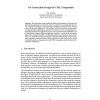Free Online Productivity Tools
i2Speak
i2Symbol
i2OCR
iTex2Img
iWeb2Print
iWeb2Shot
i2Type
iPdf2Split
iPdf2Merge
i2Bopomofo
i2Arabic
i2Style
i2Image
i2PDF
iLatex2Rtf
Sci2ools
AKA
2004
2004
On Transaction Design for UML Components
: The transaction concept enables the efficient development of concurrent and fault tolerant applications. Transaction services are therefore an essential part of modern component technologies, such as Enterprise JavaBeans, which are used to develop server-side business applications. The container, which is the execution environment of component-based applications, provides the services and uses corresponding configuration information to apply them properly. The required transactional behavior can be specified by using pre-defined configuration attributes. A result of this declarative approach are separate workflows for designing business and transaction logic. In this paper, we argue that existing methods for component-based development lack adequate support for transaction design. We then describe a model-driven process, which is directed towards an integration with the UML components method elaborated by Cheesman and Daniels.
AKA 2004 | Fault Tolerant Applications | Software Engineering | Transaction Concept | Transaction Services |
| Added | 30 Oct 2010 |
| Updated | 30 Oct 2010 |
| Type | Conference |
| Year | 2004 |
| Where | AKA |
| Authors | Sten Loecher |
Comments (0)

